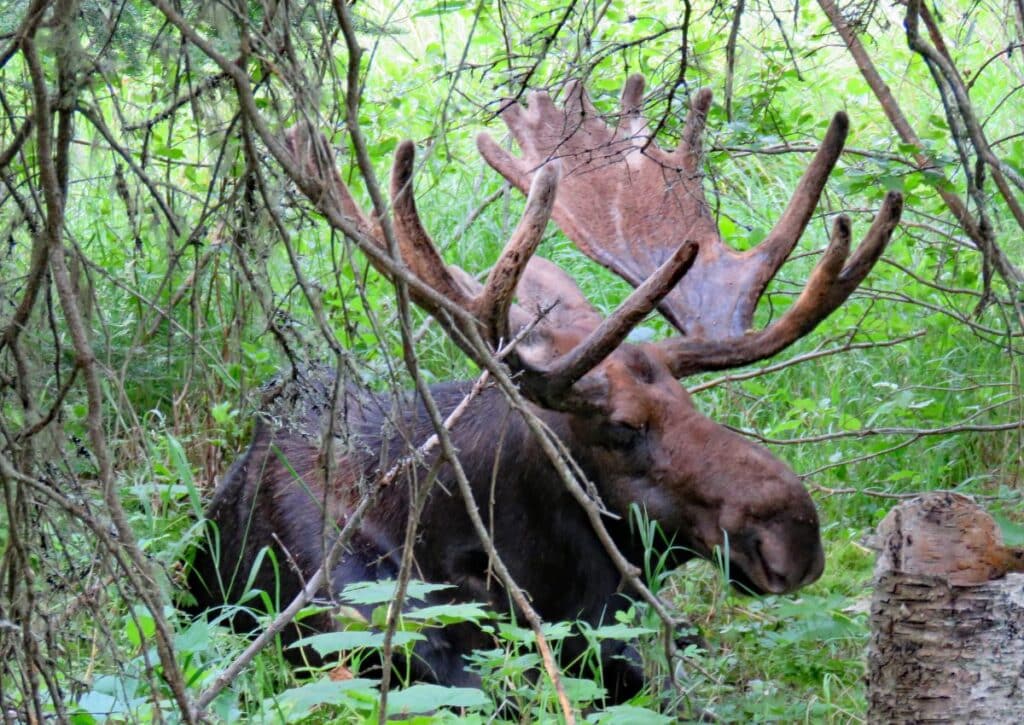Spot 13 animals in Isle Royale National Park—moose to loons. See our hiking wildlife encounters!
Strap on your hiking boots and grab your binoculars, because we’re about to spill the secrets of Isle Royale National Park’s animal inhabitants! This isn’t just a walk in the park—it’s a front-row ticket to Mother Nature’s live show.
Over countless treks, through spring’s thaw to winter’s chill, we’ve become regulars in these woods, and you wouldn’t believe the critter friends we’ve made along the way!
Imagine bumping into the majestic moose or locking eyes with elusive wolves. Picture a serene moment with the common loon or a playful encounter with a river otter.
Isle Royale isn’t just scenic; it’s a bustling hub of wildlife activity, where every trail promises a new surprise. From furry to feathered, from hopping amphibians to silent-winged raptors, we’ve seen it all.
So, lace up—let’s share with you the wild, whiskered, and winged wonders of this unspoiled paradise. Ready for an adventure? Because Isle Royale’s animals are already waiting for their close-up!
13 Animals We Saw While on a Hiking Trip at Isle Royale National Park
Over the past decade, we’ve embarked on countless hiking trips across Isle Royale National Park, traversing its rugged landscapes in every season.
Rain or shine, summer or winter, the park’s diverse wildlife never ceased to amaze us.
From the quiet rustle of a squirrel in the underbrush to the distant call of a loon echoing across the waters, each journey offered unique encounters. We’ve been fortunate to cross paths with 15 different species, each with their own story etched into the park’s ecosystem.
Here’s a look back at our memorable wildlife encounters and the fascinating insights we’ve gathered along the way.
Moose
Moose are truly an iconic sight in Isle Royale National Park, remarkable for their size and grandeur.
As the largest members of the deer family, these majestic creatures often roam in the park’s dense boreal forests and around its myriad of inland lakes.
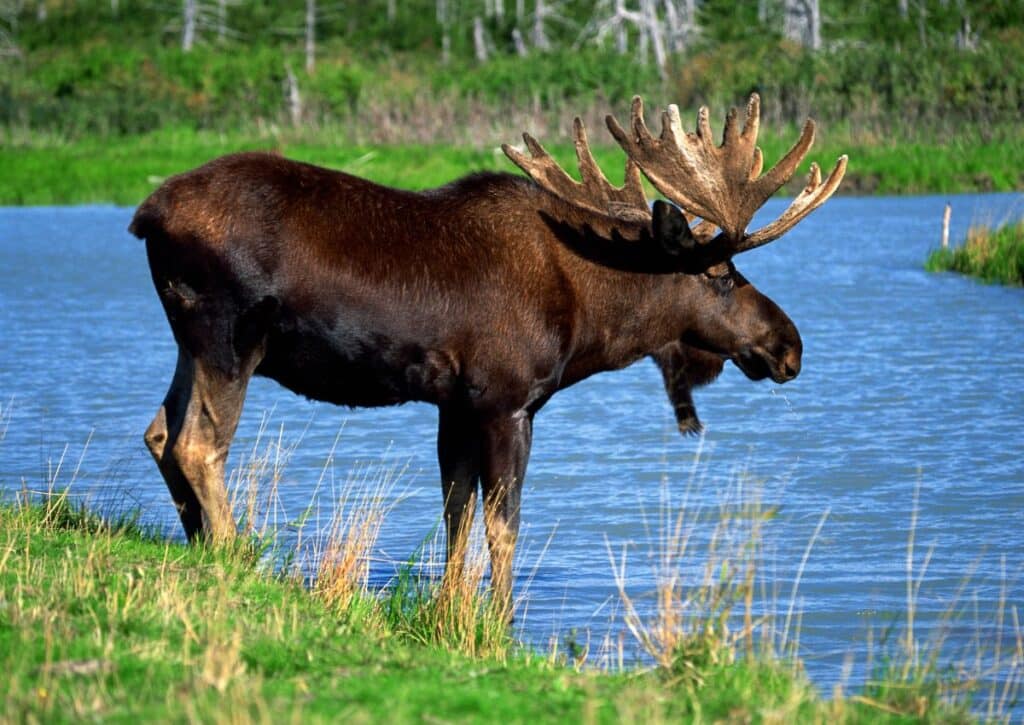
One of the best places to spot them is along the Greenstone Ridge Trail, where the forest opens up to wetland clearings.
Here, you may catch a glimpse of a moose munching on aquatic vegetation or even spot a mother with her calf. Remember, while they may seem calm, always give these powerful animals the space and respect they deserve.
Gray Wolves
The Gray Wolf, a symbol of wilderness and solitude, is an integral part of Isle Royale National Park’s ecosystem.
These elusive creatures primarily inhabit the park’s extensive boreal forests, leaving their paw prints in the soft earth and their eerie howls echoing among the trees.
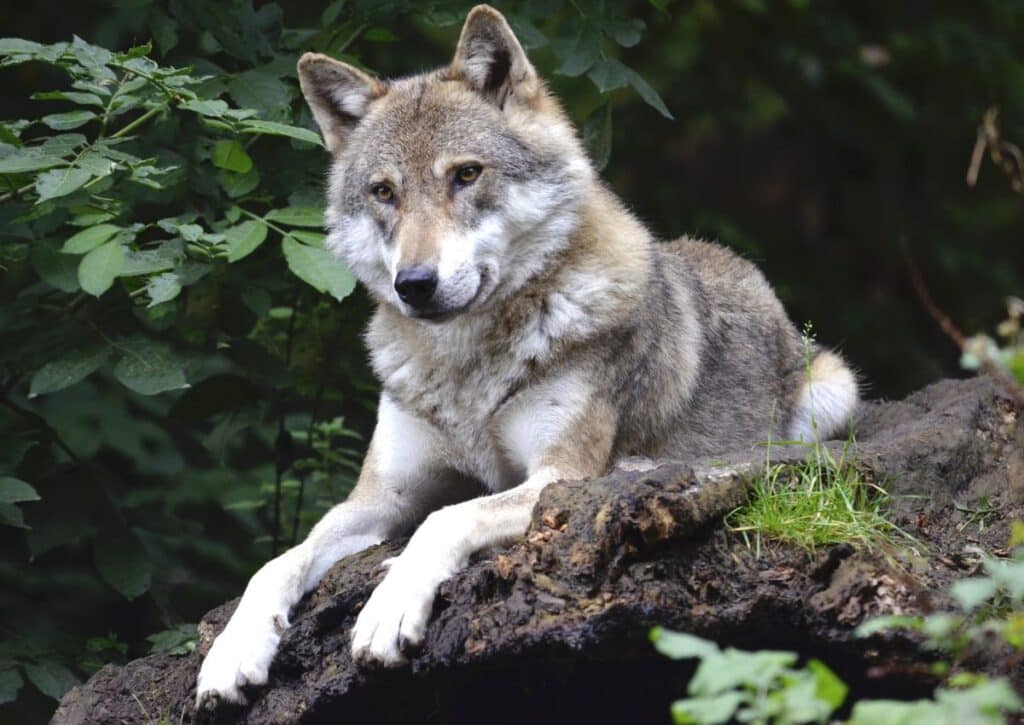
Though seeing a wolf might be a rare treat for visitors due to their secretive nature and tendency to avoid human-populated areas, there’s a certain thrill in just knowing they’re there, playing their role in nature’s grand scheme.
Occasionally, adventurous hikers on the park’s remote Minong Ridge Trail might catch a fleeting glimpse of these magnificent animals. This trail, located in the wilder northern regions of the park, passes through the wolves’ preferred habitats.
You might spot their tracks, or if you’re lucky, see them hunting, playing, or simply trotting along in the distance.
The mystery that surrounds these creatures adds to the allure and raw beauty of Isle Royale. But remember, they are wild and should always be respected from a safe distance.
Common Loon
The hauntingly beautiful call of the Common Loon is a signature soundtrack of Isle Royale National Park. Known for their striking black-and-white plumage and piercing red eyes, these aquatic birds are an integral part of the park’s vibrant ecosystem.
They favor the park’s pristine water bodies, where they’re often spotted diving for fish or gracefully floating on the surface.
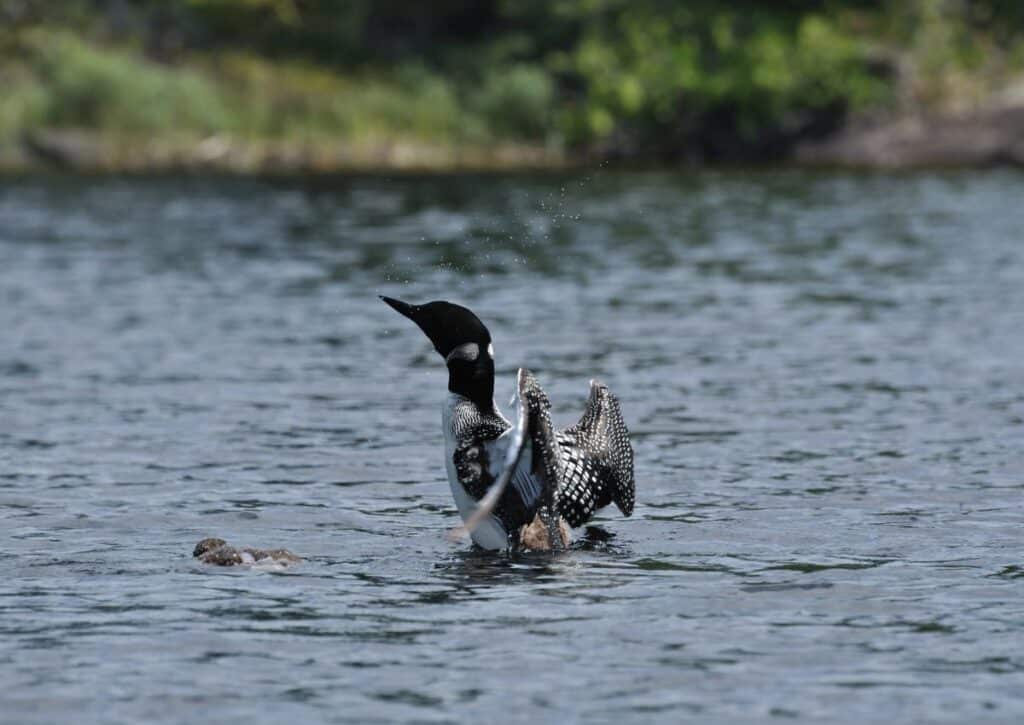
One of the best places to spot these splendid birds is around Rock Harbor. Embarking on the Stoll Trail, a scenic path that winds along the water’s edge, offers excellent opportunities for loon sightings.
Along this trail, you might encounter these magnificent birds as they court, nest, and raise their chicks, offering a fascinating window into their lives.
When listening to the loon’s poignant calls that echo across the water, it’s easy to understand why they’ve become a symbol of wild places and pristine waters.
The common loon’s presence adds a touch of magic to any Isle Royale visit, reinforcing the park’s wilderness identity.
North American River Otter
Playful, agile, and highly adapted to aquatic life, the North American River Otter is another captivating creature that calls Isle Royale National Park home.
Sleek and quick, they’re often seen diving, swimming, or sliding on their bellies along the park’s numerous freshwater shorelines and rivers, adding an element of joy and playfulness to the wilderness.
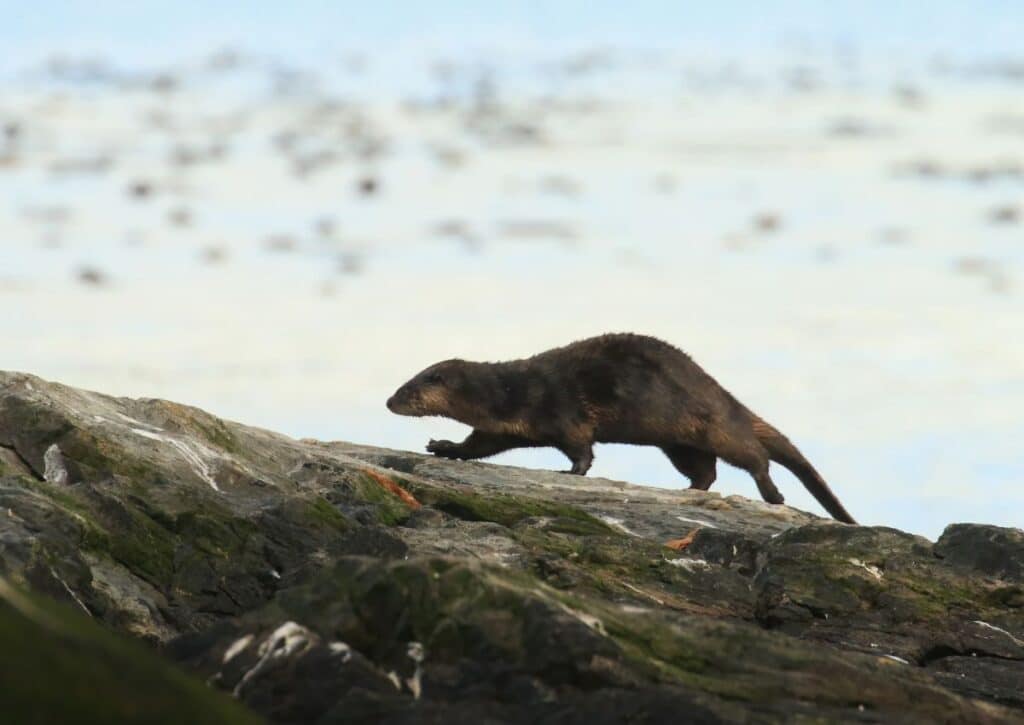
One of the best areas to spot these engaging mammals is around Tobin Harbor. Hikers exploring the Tobin Harbor Trail, which follows the serene shoreline, can often spot otters frolicking in the water, playfully chasing each other, or hunting for fish.
Their acrobatic underwater maneuvers and social behaviors are truly a spectacle.
Even though river otters are generally elusive, their active nature and preference for waterside habitats increase the chances of sightings, especially at dawn or dusk.
Observing a North American River Otter in its natural environment is a delight that underscores the natural wealth of Isle Royale National Park.
Red Squirrel
Charming and industrious, the Red Squirrel is a lively resident of Isle Royale National Park. Known for their bright reddish fur and bushy tails, these small creatures are surprisingly vocal, often chattering and scolding intruders from their lofty perches.
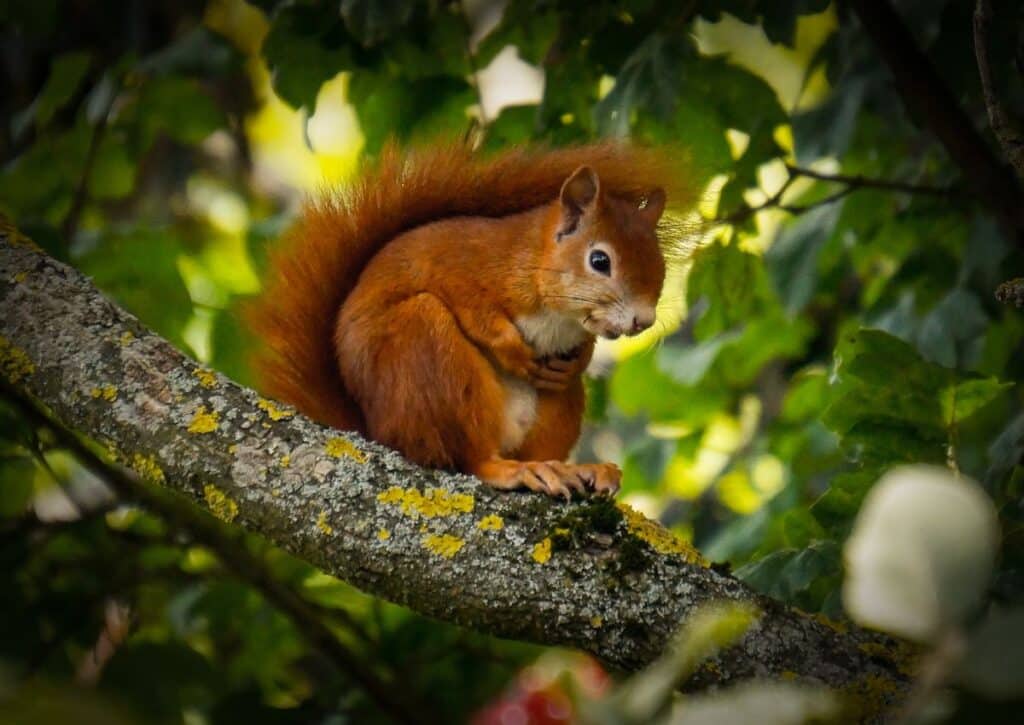
A variety of trails offer glimpses of these agile climbers, but the Windigo Nature Trail is particularly favorable. Meandering through mixed hardwood and conifer forests, this trail provides the perfect habitat for Red Squirrels.
As you stroll along, you might spot them darting up tree trunks, leaping between branches, or busily stashing away pine cones for the winter.
Red Squirrels bring a dash of color and a flurry of activity to the serene landscapes of Isle Royale. Despite their small size, they play a significant role in the park’s ecosystem, spreading seeds and providing food for predators.
Catching sight of a Red Squirrel, with its distinctive twitching tail, is always a delightful moment during a hike in the park.
Snowshoe Hare
Adapted to the seasonal extremes of Isle Royale National Park, the Snowshoe Hare is a fascinating creature to observe.
Named for their large hind feet that act like natural snowshoes, these hares are most recognized for their color-changing coat, which turns from brown in the summer to white in winter for ultimate camouflage.
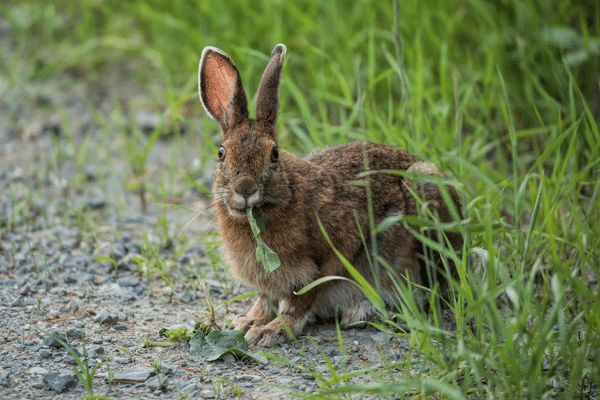
The Greenstone Ridge Trail, a high ridgeline that stretches across the park, is a promising place to see these hares. It offers a variety of habitats including mixed forests and meadows, the preferred environments of the Snowshoe Hare.
Here, they can be seen bounding through underbrush or, if you’re lucky, transitioning between their summer and winter coats.
Spotting a Snowshoe Hare, particularly in its pristine white winter coat against the snowy backdrop, is a memorable encounter.
Their ability to thrive in the rugged landscapes of Isle Royale National Park is a testament to the wonders of nature’s adaptability.
Beaver
The industrious Beaver, North America’s largest rodent, is a keystone species of Isle Royale National Park.
These hardworking creatures are renowned for their dam-building skills, which create habitats that support an astonishing array of wildlife.
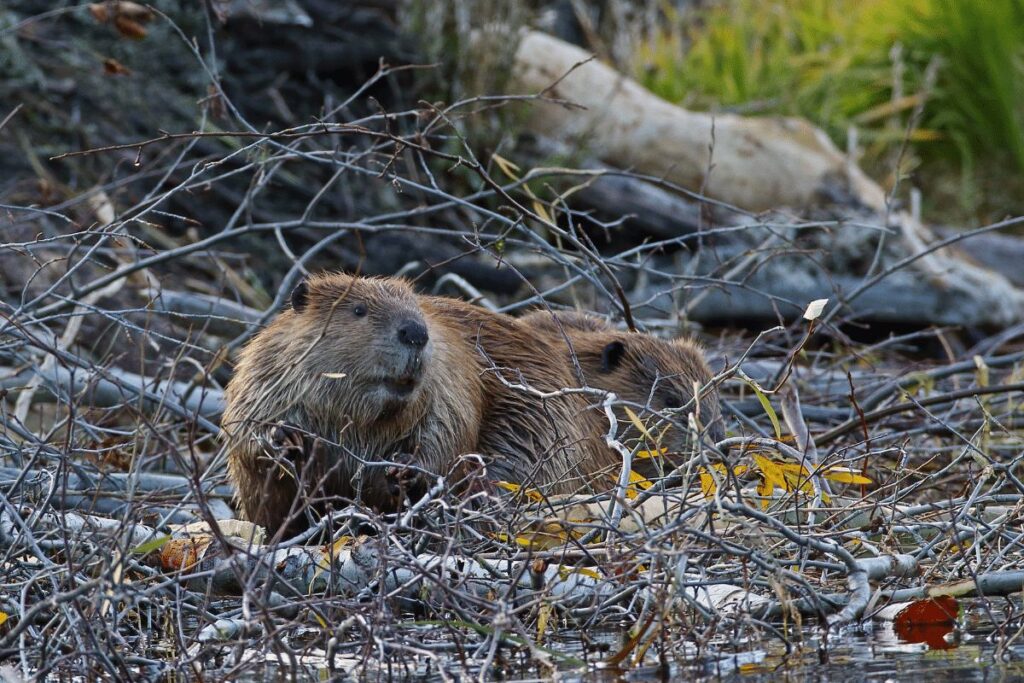
If you’re hoping to spot a beaver in action, the aptly named Beaver Island Trail is a must-visit. Located near McCargoe Cove campground, this trail offers an abundance of wetland habitats.
You may not only spot a beaver, but also discover their impressive log and mud dams and lodges.
By dusk, you can often see them busily patrolling their pond, repairing their dam, or foraging for food.
The ripples they create as they glide through the water, the sound of their powerful tail slapping the surface—these are sights and sounds that truly capture the essence of Isle Royale’s wilderness.
Witnessing the work of a beaver, nature’s engineer, is an unforgettable encounter that highlights the interconnectedness of the park’s ecosystem.
Bald Eagle
Embodying power, freedom, and the wild spirit of Isle Royale National Park, the Bald Eagle is a majestic sight.
With their striking white heads, dark bodies, and impressive wingspans, they rule the skies above the park, scanning the waters for their next meal.
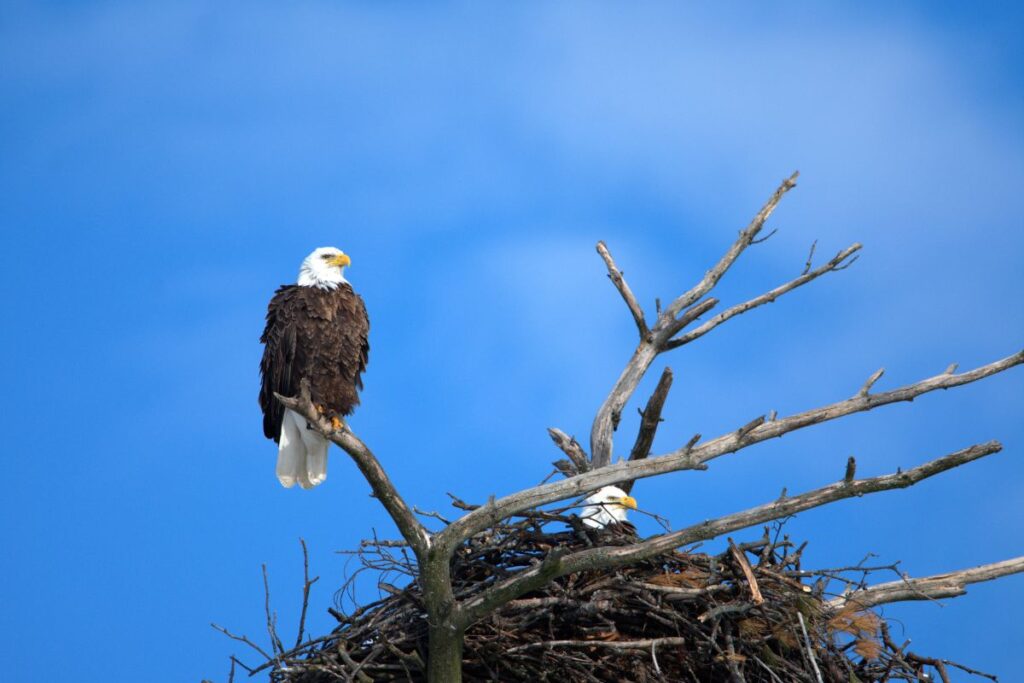
One of the best places to watch these raptors is from the Hidden Lake Overlook on the Mount Franklin Trail.
This vantage point offers panoramic views of the park, including its numerous water bodies, where Bald Eagles are often seen soaring in search of fish.
There’s a certain thrill in spotting a Bald Eagle as it rides the thermals, circles over the trees, or swoops down to snatch a fish from the water.
Their presence adds an extra layer of awe to the park’s already inspiring landscapes. The sight of a Bald Eagle, whether perched regally or soaring high, is a remarkable moment that underlines the wild essence of Isle Royale.
Red-tailed Hawk
A common sight in the skies over Isle Royale National Park, the Red-tailed Hawk is known for its distinctive reddish-brown tail and impressive hunting prowess.
These formidable birds of prey add a dynamic element to the park’s biodiversity, patrolling the skies in search of rodents and small mammals.
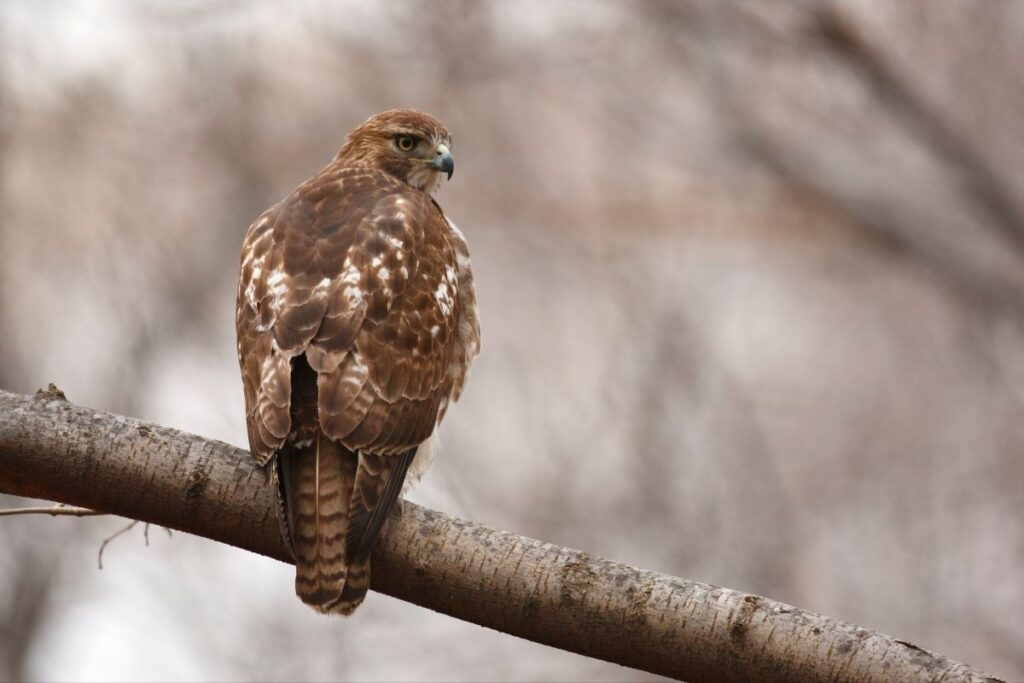
A promising location to catch sight of these raptors is along the Ojibway Fire Tower Trail. This trail offers high vantage points that not only showcase the park’s expansive beauty but also provide excellent opportunities for spotting Red-tailed Hawks.
You might see them soaring effortlessly on thermal currents, their broad wings spread wide and distinctive red tail catching the light.
Whether you’re a seasoned birdwatcher or just a nature enthusiast, watching a Red-tailed Hawk in flight is a remarkable spectacle.
Their commanding presence is a testament to the health and vitality of Isle Royale’s ecosystems, and spotting one is always a memorable highlight of any visit to the park
Boreal Chorus Frog
The Boreal Chorus Frog may be small in size, but its distinctive call, reminiscent of a thumb being drawn along the teeth of a comb, provides an enchanting background chorus in Isle Royale National Park.
These tiny frogs, with their strikingly beautiful skin patterns, come to life after the winter’s thaw, filling the air with their harmonious melodies.
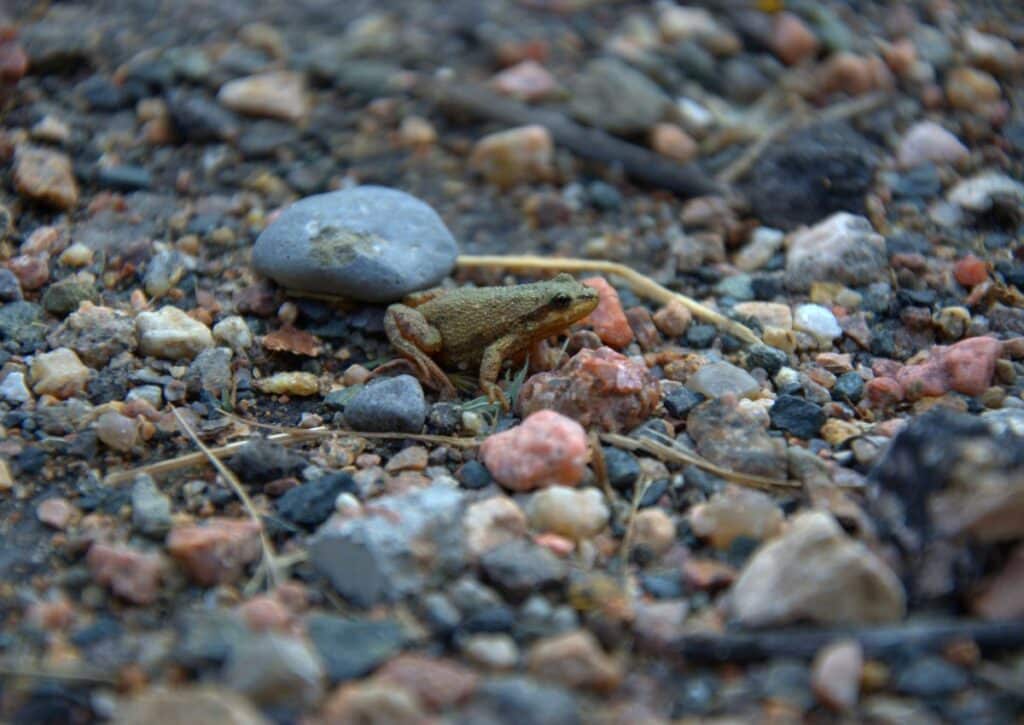
Hikers exploring the Daisy Farm Trails, particularly the trails passing near small ponds and wetlands, have a good chance of hearing, if not seeing, these vocal amphibians.
After a rainfall or at dusk, their chorus reaches a crescendo, creating a captivating soundscape that resonates with the soul of Isle Royale.
Though they may often remain unseen, tucked away in the vegetation or partially submerged in pond water, their cheerful symphony is a reminder of the smaller, yet significant inhabitants of the park.
Encountering the Boreal Chorus Frog is a delightful sensory experience that enhances any journey through Isle Royale.
Painted Turtle
Known for their vibrant shell markings, Painted Turtles are a delightful presence in Isle Royale National Park’s diverse aquatic habitats.
These colorful reptiles can be spotted basking in the sun on logs or rocks near the park’s numerous freshwater bodies.
A prime location to spot these aquatic dwellers is around Lake Richie, with the Lake Richie Trail providing ideal viewing opportunities.
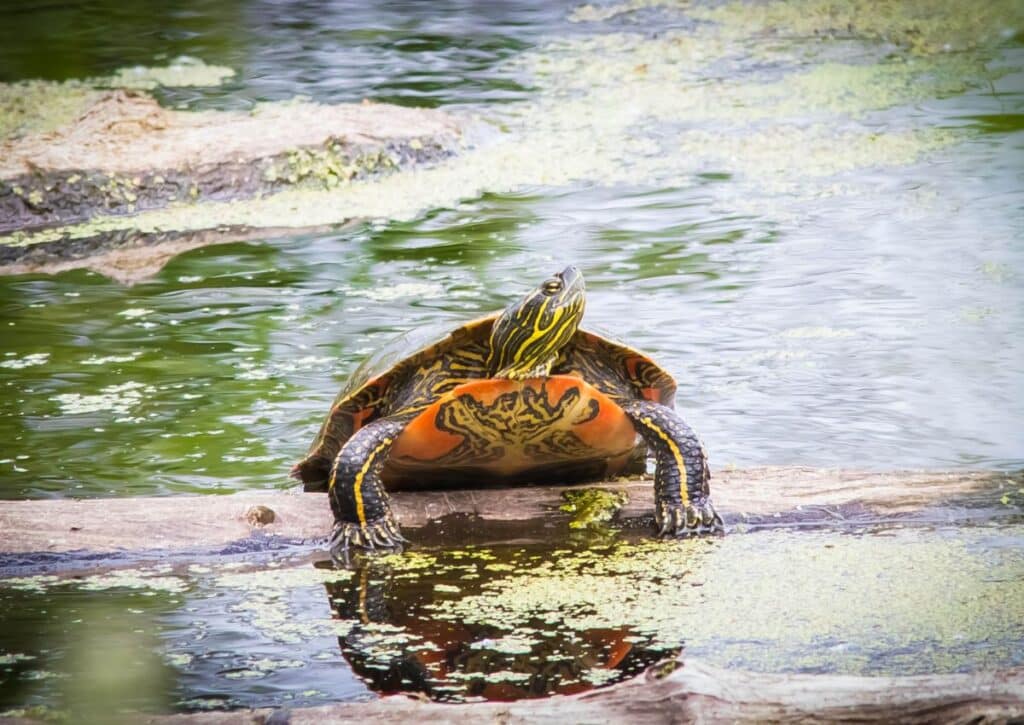
Here, as you wander through the verdant landscapes, you might notice these turtles enjoying the sun’s warmth, their brightly patterned shells offering a splash of color against the neutral hues of the lake.
Though generally shy, Painted Turtles play an important role in the park’s ecosystems, contributing to the balance of aquatic life. Their presence serves as an indicator of clean, healthy waters.
Spotting a Painted Turtle, with its distinctive shell glistening in the sun, is a charming and memorable aspect of exploring Isle Royale’s rich biodiversity.
Red-Breasted Merganser
Among the diverse avian life of Isle Royale National Park, the Red-breasted Merganser holds a place of distinction. Known for their spiky crests and elongated, red-tinted bodies, these diving ducks are a delightful sight as they skim across the park’s water bodies or dive under the surface in pursuit of fish.
For birdwatchers and nature enthusiasts, the Rock Harbor Lighthouse Trail presents an excellent opportunity to observe these unique waterfowl.
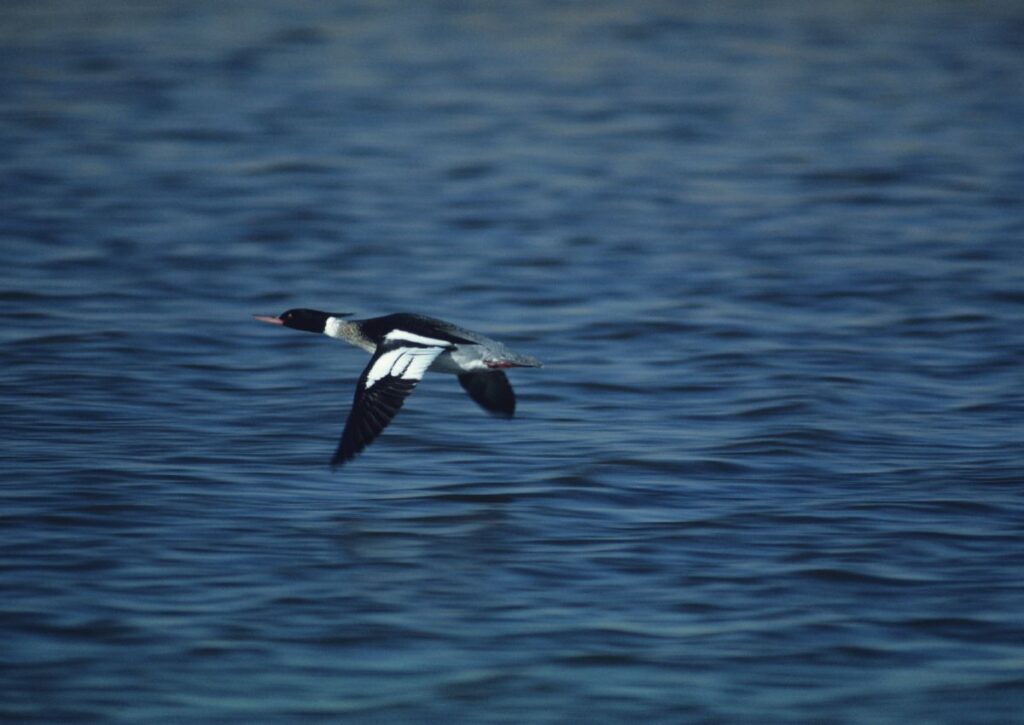
The trail meanders along the harbor’s edge, providing a blend of coastal and woodland habitats that these birds favor.
You might see them engaging in their peculiar feeding behavior, disappearing beneath the water’s surface and emerging moments later with their catch.
The Red-breasted Merganser is one of the many avian gems of Isle Royale, their distinctive appearance and habits adding to the park’s rich tapestry of wildlife.
Observing these ducks in their natural habitat is a joy that underscores the natural diversity of Isle Royale National Park.
Lake Trout
The clear, cool waters of Isle Royale National Park are a haven for Lake Trout, a species prized by anglers and vital to the aquatic ecosystem.
Known for their resilience and longevity, these fish are a testament to the health of the park’s numerous lakes and waterways.
For those interested in fishing or simply observing the teeming life beneath the water’s surface, the Minong Ridge Trail offers fantastic opportunities.
This trail crosses several streams and lakes, including the large and pristine Lake Desor, a prime location for Lake Trout.
Lake Trout, with their silvery-green bodies and pinkish-red spots, are a sight to behold whether you’re reeling one in on a line or watching them dart through the crystal-clear water.
Their presence enhances the park’s biodiversity and contributes significantly to the park’s food chain, making them a critical part of Isle Royale’s complex, interconnected wilderness.
Wolves and Moose on Isle Royale
Venturing into the wild heart of Isle Royale National Park, you’ll find yourself woven into an age-old tale of survival, a tale starring two of the park’s most iconic inhabitants: the Gray Wolf and the Moose.
These two species represent the quintessential predator-prey relationship, an intricate dance of survival that plays out amidst the island’s rugged landscapes.
Isle Royale’s majestic Moose and elusive Gray Wolves have been part of the island’s narrative since the early 20th century.
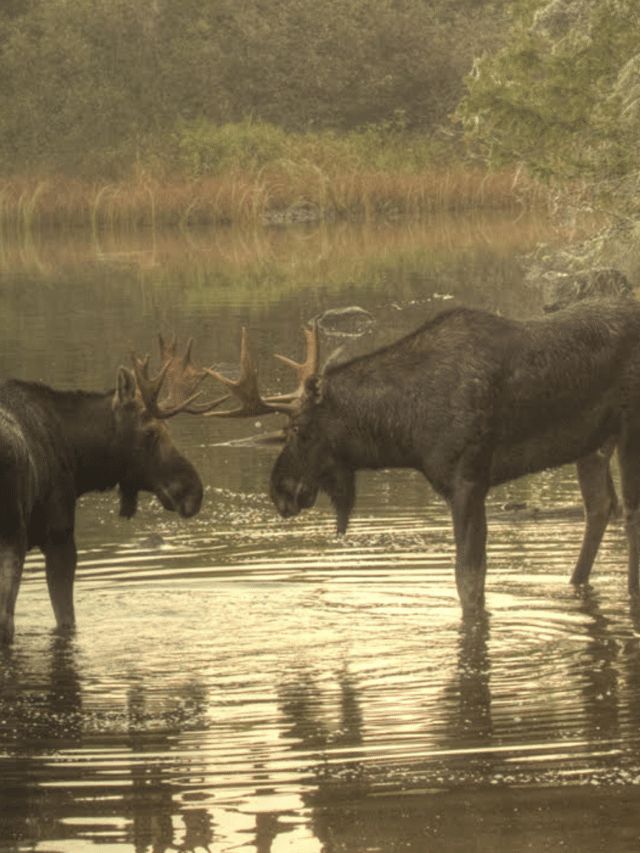
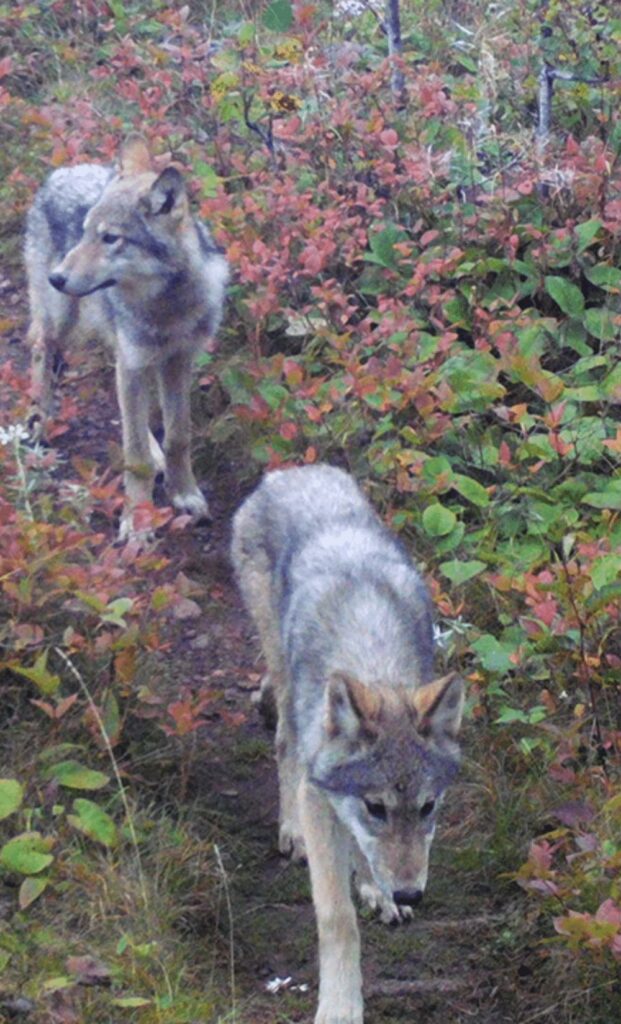
The Moose, with their towering antlers and formidable size, swam over from mainland Canada, while the Wolves, cunning and agile, crossed an ice bridge during a particularly cold winter.
This set the stage for a unique ecological drama that has been unfolding for nearly a century.
The relationship between these two species is a complex one, the Wolf as predator and the Moose as prey. This dynamic dictates not only their individual survival but shapes the entire landscape of Isle Royale.
The ebbs and flows in their populations influence the vegetation and other wildlife, creating ripples that resonate throughout the island’s ecosystem.
Yet, the Wolves and Moose of Isle Royale aren’t merely surviving; they are living case studies.
The island has been home to the world’s longest-running predator-prey study, with scientists braving the harsh winters and isolated terrain for over 60 years to glean insights into this dynamic relationship.
The data gathered has shed light on the intricacies of island biogeography, predator-prey interactions, and the impact of climate change.
Each howl of the Wolf, each footfall of the Moose, echoes with tales of endurance, adaptation, and the delicate balance of nature.
Their saga serves as a reminder of our duty to safeguard such wild spaces, allowing this captivating ecological symphony to continue playing for generations to come.
Wildlife Trails in Isle Royale National Park
Amidst the pristine wilderness of Isle Royale National Park are trails that beckon both the hiker and the wildlife enthusiast. These trails offer more than just a walk; they promise a journey through habitats teeming with creatures both large and small.
Minong Ridge Trail begins at the McCargoe Cove and stretches for a challenging 28 miles. As you navigate its rugged terrains, the dense canopy overhead might treat you to the delightful chattering of Red Squirrels or the soft footsteps of Snowshoe Hares hopping in the underbrush.
But what makes this trail genuinely exceptional is the possibility of spotting the park’s famed wolves and the majestic moose. Their presence transforms this hike from a mere walk to a thrilling exploration.
On the other hand, the Greenstone Ridge Trail, which starts at the Windigo Visitor Center and spans a robust 40 miles, offers an entirely different spectacle.
As the longest and highest ridge on Isle Royale, it presents panoramic views of the park’s vast expanse. As you tread its path, the sky above might suddenly be graced by the shadow of a Red-tailed Hawk or the powerful wings of a Bald Eagle.
This trail isn’t just about the views; it’s about the symphony of nature sounds, from distant bird calls to the rustling of leaves as animals move stealthily in the undergrowth.
For those who prefer the soothing ambiance of water, the Rock Harbor Trail is a gem. This 10.4-mile trail gently traces the contours of Rock Harbor’s shoreline.
As the waves lap at the rocks and the breeze carries the scent of freshwater, keep an eye out for the playful North American River Otter or even the diligent beaver working on its dam.
Side-trails branching off this main trail lead to serene inland lakes, where on a lucky day, you might spot the Painted Turtle sunbathing on a log.
Lastly, the Stoll Trail, although shorter at 4.2 miles round trip to Scoville Point, is no less enriching. The undulating terrains and scenic overlooks are a haven for birdwatchers.
The haunting call of the Common Loon or the swift dive of the Red-Breasted Merganser catching a fish can be regular sights and sounds here.
Hiking in Isle Royale National Park is about immersing oneself in a world where nature reigns supreme. It’s about the unexpected encounters and the stories they spawn.
So, as you lace up your hiking boots and step onto these trails, remember to tread softly, listen keenly, and look closely – for the park’s animals are its beating heart.
10 Wildlife Viewing Tips in Isle Royale National Park
Isle Royale National Park is a haven for wildlife enthusiasts. To ensure you make the most of your visit while maintaining safety and respect for the park’s inhabitants, consider the following tips:
- Dawn and Dusk are Prime Time: Many animals, like the park’s iconic moose, are crepuscular, meaning they’re most active during the early morning and late evening. Plan hikes or sit quietly near known watering spots during these times for the best viewing opportunities.
- Tread Quietly: The more silently you move, the better your chances of observing wildlife. Avoid loud noises or sudden movements that can scare away animals.
- Maintain Distance: While it might be tempting to approach a moose or wolf for a closer look or photo, it’s crucial for your safety and the animal’s well-being to keep a safe distance. Binoculars or a zoom lens for your camera can help you get a closer look without getting physically close.
- Use the Water: Isle Royale is an island, and some of the best wildlife sightings can be from a canoe or kayak. Paddling silently can give you a vantage point to observe creatures like the North American River Otter, beavers, or waterfowl like the Common Loon.
- Stay on Designated Trails: While going off the beaten path might seem enticing, sticking to the designated trails not only ensures your safety but also reduces the impact on delicate habitats.
- Be Aware of Scent: Animals have keen noses. Avoid wearing strong perfumes or lotions, which might either attract or repel wildlife. If camping, always store food properly to avoid attracting unwanted animal guests.
- Learn the Signs: Familiarize yourself with animal tracks, droppings, and vocalizations. Recognizing these can give you clues about recent animal activity in the area and enhance your viewing experience.
- Check with Rangers: Park rangers are a wealth of knowledge. They often have the latest information on wildlife activity or recent sightings. A quick chat with them can guide you to the best viewing spots.
- Be Patient: Wildlife viewing often requires patience. Settle down at a promising spot, remain still, and wait. Nature operates on its own schedule, and patience can reward you with some unforgettable sightings.
- Leave No Trace: This principle is paramount. Whatever you bring into the park, ensure you take it out. By minimizing our impact, we ensure that the park remains a sanctuary for its wild inhabitants for generations to come.
Lastly, always remember that Isle Royale’s wilderness is the animals’ home. Our role is that of a guest, and it’s up to us to be respectful visitors.
The magic of wildlife viewing in Isle Royale lies not just in the sightings but in the profound connections we build with nature.
Conclusion
Isle Royale National Park is underrated and needs more people exploring it’s wonders!
With its pristine landscapes, dynamic wildlife, and unique ecological tale, offers an escape into a world where nature reigns supreme.
Every trail traversed, every creature spotted, every birdcall heard, adds to the rich symphony of experiences that make this park a treasured wilderness sanctuary.
As you venture out, let the park’s rhythms guide you, unveiling its many secrets and deepening your connection with the natural world.
Isle Royale isn’t just a destination; it’s a journey into the heart of the wild, an adventure that stirs the soul and captivates the senses in every possible way.

